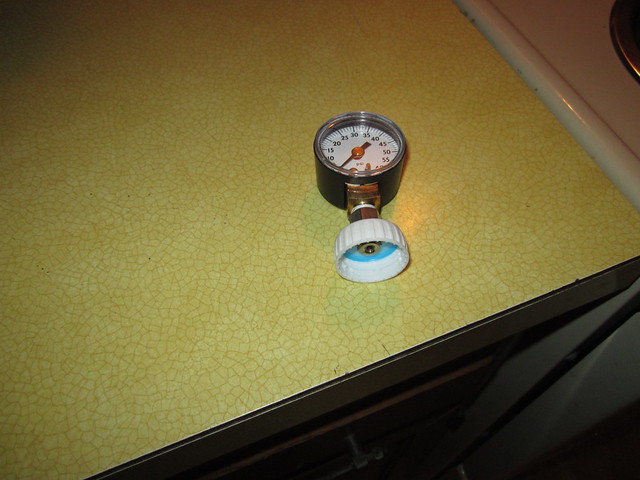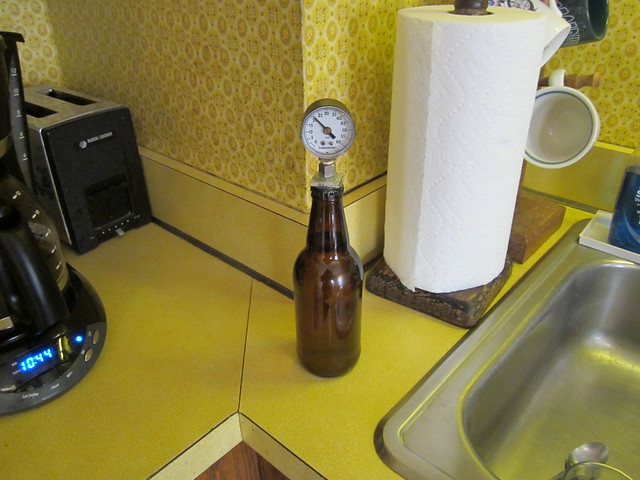Over the last few months I've been conducting some experiments in cider bottle carbonation, and I thought Id share my data with the community.
The focus of my experiments is in 3 areas. First, to come up with a way of quantifying the buildup of CO2 pressure rather than using the "squeeze the PET bottle" method. Secondly, I wanted to determine the safe level of carbonation before stovetop pasteurization, and thirdly to document the change in specific gravity when sweetening / priming / pasteurizing.
Being an engineer, I came up with this gizmo to give me some numbers

Its just a 60 PSI pressure gage attached to a soda bottle cap. The hardware consists of a 10-32 to 1/8 NPT adapter and the gage, both available from McMaster-Carr.
Stovetop Pasteurization
My first tests were to ferment some sugar water and let pressure build to 25 PSI @65°F (2.4 volumes). Then I plunked the bottle into a pot of 175° water to see what would happen. The towel in the pot is to isolate the bottle from the hot bottom surface;

Unfortunately, when the pressure got to about 40 PSI the bottle popped out the bottom:

Bummer. I repeated this 3 times with the same effect. So, I adapted my gage to a capped glass bottle and tried again:

This one had been primed to 1.010 and allowed to reach 22 PSI @ 65F, which should be 2.21 volumes. I put it into a pot of hot water drawn from the tap in my sink, and after 10 minutes at 122°F the pressure was up to 45 PSI. I replenished the tap water and after 7 minutes at 136°F the pressure got up to 55 PSI and was still rising. This is about the maximum safe pressure of a used beer bottle, according to web research Ive done and Im nowhere near 180° yet. If anyone has authoritative data on that, please chime in.
Calculations support my numbers to some extent. According to this web page:
http://www.brainlubeonline.com/GasLawsBeer.html
...and this formula:
P = -16.6999 - 0.0101059 T + 0.00116512 T^2 + 0.173354 T V + 4.24267 V - 0.0684226 V^2
There should be 64.3 PSI @ 136° and 2.21 volumes of CO2, and I think my glass bottle would have reached that if I gave it more time.
So, what is a safe level of carbonation that wont bust bottles at 180°F? That depends on how good your bottles are. From searching the web, it seems that all bottles are not created equal. Some say 4 bar (58 PSI) is the limit, others say that breweries test their bottles to 100 PSI. And according to calculations, a meager 2.0 volumes (mild carbonation IMO for cider) will reach 90 PSI @ 180.
SG After bottle carbonation
I did another set of tests to take a look at how much sugar (as measured with a hydrometer) is left after bottle conditioning. I was surprised to find that there was very little change in SG before and after. Example, 2 teaspoons of table sugar in 12 oz of water reads exactly 1.010. After carbing to 25 PSI, I measured it again and it was still 1.010, or maybe 1.009. I had 2 bottles in that test and both were the same. The actual carbonation in those samples was just what I like, and 25 PSI is when I stick em in the fridge.
Observations
-The pressure after exposure to heat did not return to the same level as before, it was higher than when I started. My theory on that is the yeast goes into overdrive and continues to add carbonation up till the point where they die.
-Squeezing the PET bottle, 15 PSI was firm and 20 PSI was hard, according to my feel. 25 PSI is rock hard.
-Stovetop pasteurizing is a risk. (Duh). I like my ciders carbonated to about 2.4 volumes, and theres no way to get there and safely expose bottles to 180°F.
I hope this info proves to be useful to some of you.
The focus of my experiments is in 3 areas. First, to come up with a way of quantifying the buildup of CO2 pressure rather than using the "squeeze the PET bottle" method. Secondly, I wanted to determine the safe level of carbonation before stovetop pasteurization, and thirdly to document the change in specific gravity when sweetening / priming / pasteurizing.
Being an engineer, I came up with this gizmo to give me some numbers

Its just a 60 PSI pressure gage attached to a soda bottle cap. The hardware consists of a 10-32 to 1/8 NPT adapter and the gage, both available from McMaster-Carr.
Stovetop Pasteurization
My first tests were to ferment some sugar water and let pressure build to 25 PSI @65°F (2.4 volumes). Then I plunked the bottle into a pot of 175° water to see what would happen. The towel in the pot is to isolate the bottle from the hot bottom surface;

Unfortunately, when the pressure got to about 40 PSI the bottle popped out the bottom:

Bummer. I repeated this 3 times with the same effect. So, I adapted my gage to a capped glass bottle and tried again:

This one had been primed to 1.010 and allowed to reach 22 PSI @ 65F, which should be 2.21 volumes. I put it into a pot of hot water drawn from the tap in my sink, and after 10 minutes at 122°F the pressure was up to 45 PSI. I replenished the tap water and after 7 minutes at 136°F the pressure got up to 55 PSI and was still rising. This is about the maximum safe pressure of a used beer bottle, according to web research Ive done and Im nowhere near 180° yet. If anyone has authoritative data on that, please chime in.
Calculations support my numbers to some extent. According to this web page:
http://www.brainlubeonline.com/GasLawsBeer.html
...and this formula:
P = -16.6999 - 0.0101059 T + 0.00116512 T^2 + 0.173354 T V + 4.24267 V - 0.0684226 V^2
There should be 64.3 PSI @ 136° and 2.21 volumes of CO2, and I think my glass bottle would have reached that if I gave it more time.
So, what is a safe level of carbonation that wont bust bottles at 180°F? That depends on how good your bottles are. From searching the web, it seems that all bottles are not created equal. Some say 4 bar (58 PSI) is the limit, others say that breweries test their bottles to 100 PSI. And according to calculations, a meager 2.0 volumes (mild carbonation IMO for cider) will reach 90 PSI @ 180.
SG After bottle carbonation
I did another set of tests to take a look at how much sugar (as measured with a hydrometer) is left after bottle conditioning. I was surprised to find that there was very little change in SG before and after. Example, 2 teaspoons of table sugar in 12 oz of water reads exactly 1.010. After carbing to 25 PSI, I measured it again and it was still 1.010, or maybe 1.009. I had 2 bottles in that test and both were the same. The actual carbonation in those samples was just what I like, and 25 PSI is when I stick em in the fridge.
Observations
-The pressure after exposure to heat did not return to the same level as before, it was higher than when I started. My theory on that is the yeast goes into overdrive and continues to add carbonation up till the point where they die.
-Squeezing the PET bottle, 15 PSI was firm and 20 PSI was hard, according to my feel. 25 PSI is rock hard.
-Stovetop pasteurizing is a risk. (Duh). I like my ciders carbonated to about 2.4 volumes, and theres no way to get there and safely expose bottles to 180°F.
I hope this info proves to be useful to some of you.














![Craft A Brew - Safale S-04 Dry Yeast - Fermentis - English Ale Dry Yeast - For English and American Ales and Hard Apple Ciders - Ingredients for Home Brewing - Beer Making Supplies - [1 Pack]](https://m.media-amazon.com/images/I/41fVGNh6JfL._SL500_.jpg)











































